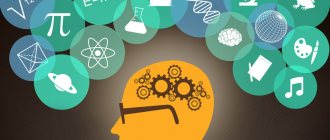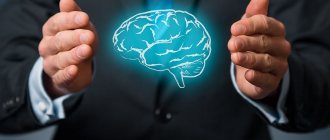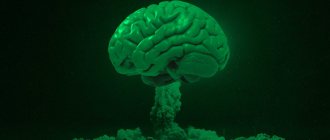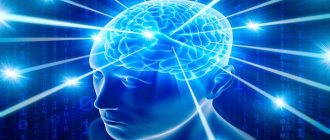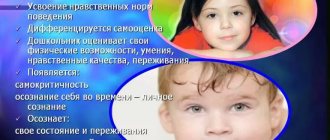Thanks to the ability to think, people can analyze information, draw conclusions, draw analogies and engage in cognitive activities. Thus, the scope of the surrounding world expands and is not limited only to its material aspects. In this article I will tell you what types of thinking exist in psychology, give them characteristics using tables, and give examples.
What is thinking
Thinking is a cognitive process that allows a person to perceive, realize reality and express this in his own activities. It endows surrounding objects with properties and relationships with each other. Thanks to mental activity, each person’s picture of the world is formed.
There are the following main signs of thinking:
- Mediation – cognitive activity is based on data from the senses and does not interact directly with reality;
- Generalization is the ability to find common properties in objects of the same type.
These characteristics are inherent in every person. In mental illness, a disorder in the basic features of thought processes may occur - for example, the search for similarities in dissimilar objects.
Right-brain and left-brain thinking
Each hemisphere is characterized by the predominance of certain processes. Based on this feature, the main types of thinking were identified:
- Left hemisphere - the process is dominated by analytical and synthetic processes, logical constructions;
- Right-hemisphere - relies on images and intuition;
- Mixed is the alternate work of each hemisphere;
- Integrated – simultaneous work of both hemispheres.
It is wrong to say that one type of mental activity is preferable to another. Each of them is capable of coming to both correct and incorrect conclusions. Left-hemisphere thinking gives leadership qualities, right-hemisphere thinking gives a strong emotional response. Mixed, thanks to its ability to “switch,” can use the strengths of both hemispheres. But this process does not always happen on time. The same goes for the integrated type.
Classification
In psychology, types of thinking are distinguished depending on the way a person comes to conclusions:
- Visual-effective - cognitive activity based on the perception of specific objects and manipulations with them;
- Visual-figurative – relies on images and judgments, allows the use of specific images to illustrate conclusions;
- Verbal-logical – based on logical constructions and inferences. Able to reason about abstract concepts;
- Subject-effective – close to visual-effective. Used to solve applied problems;
- Empirical - using lived experience to make inferences.
Each person has all types to one degree or another. The verbal-logical or abstract type develops later than the others. Characteristic only for humans. Other types appear to varying degrees in some animals. In essence, abstract thinking allows a person to use a wide conceptual apparatus and transfer knowledge through indirect sources - a book, an educational film, etc.
Visually effective type
This is the earliest form of mental activity that develops in humans. It is typical for children under 3 years of age. Mental operations are based on manipulations with really existing tangible objects. Each problem is solved immediately at the practical stage, during manipulations with objects. Thinking disorders of this type are rare. Mainly with severe mental retardation. They lead to the fact that the process of development of brain activity as a whole slows down or stops.
How and when does developmental disorder develop?
This is the first stage in the development of mental activity. The time frame for its development to begin varies. Some experts indicate that a child is capable of simple mental operations from birth. Others say that the development of mental processes is closely related to the ability to move and appears simultaneously with a decrease in muscle hypertonicity. Estimated time frame: 6 months – 1 year.
Vivid and uncontrolled manifestations of visual-effective thinking in children over 3 years of age, adolescents and adults indicate serious mental disorders - mental retardation, regression in psychosis. The patient exhibits a pronounced desire to grab, break and hide surrounding objects.
Manual or visual-effective thinking of children and ways of its development
This type of solving life problems got its name due to the fact that the child constantly performs some kind of manipulation with surrounding objects. The most striking manifestations are the baby grabbing toys, knocking them, testing them, licking them, trying to take them apart and put them back together.
It makes no sense to wean a child from these manipulations; a much more important task for parents is to provide the child with toys that he can disassemble and assemble without damaging them. An excellent option is sorters. This educational toy has many functions and modifications. The principle of operation is usually similar - assemble, disassemble, correlate colors, edges, shapes. This is both a puzzle and a construction set in one toy. Check out the selection of smart toys in different prices and variations.
Visually effective type of thinking in adults
In adults, such mental operations are involved in cases where the result of actions cannot be predicted on the basis of existing inferences. A striking example is mastering an unfamiliar technique. Arrangement of furniture in the room or objects on the table, selection of necessary materials according to shape, texture, subjective sensations.
Disorders
Thought disorders are disorders of mental activity. Violation is divided into quantitative and qualitative.
Quantitative forms of the disorder are characterized by speech impairment, delayed neuropsychological development, or mental retardation.
Forms of quantitative disorder:
- Mental retardation (MDD) is diagnosed in children 2-3 years old. Treatment is prescribed by a neurologist.
- Oligophrenia (mental retardation is characterized by impaired development of a child from an early age). A child with oligophrenia is observed by a neurologist and psychotherapist. The goal of treatment will be socialization and learning self-care.
- Dementia is a disorder of mental processes that manifests itself in adulthood or adolescence. Observation by a psychotherapist.
The speed of thinking depends on the predominance of processes in the cerebral cortex. This may be excessive excitement or, on the contrary, inhibition of mental activity:
- Disruption is characterized by a rapid change of thought, in which speech becomes absurd, logic and consistency of judgments are completely absent. Speech consists of fragments of phrases quickly replacing each other. The grammar of speech is usually preserved. This disorder is inherent in schizophrenia.
- Manic syndrome is characterized by accelerated speech and a simultaneous increase in psycho-emotional background. Speech is accelerated, the patient can speak “excitedly”, especially pronounced in certain topics.
- Slowing down of mental processes is inherent in depressive syndrome. Distinctive features: absence of thoughts in the head, slow speech taking into account the slightest details that are not related to the essence of the issue, predominance of a depressed mood.
- Thoroughness is expressed in excessive “drowning” in details. The patient has difficulty switching from one question to another, and rigidity of thinking is observed. Circumstances are inherent in diseases of the nervous system (Epilepsy).
- Reasoning is revealed during long-term communication and is expressed by a tendency to teach. When a person does not answer the question posed, but talks about things that have nothing to do with him and strives to teach life to everyone with whom he begins to communicate.
- Autism develops in withdrawn people. A distinctive feature of this disorder will be isolation from the world, poor orientation in society and immersion in internal experiences, which often do not correspond to the real state of affairs.
- Obsessive syndrome is characterized by obsession with ideas or thoughts that the patient cannot get rid of, although he understands the absurdity. Obsessive thoughts depress a person, cause negative emotions, make them suffer, but the patient cannot cope with them. They arise against the background of persistent excitation of a part of the nervous system.
- Phobias (unreasonable fear) . Various phobias arise against the background of overexertion and performing a difficult task for an adult or child. In childhood, fear of punishment gives rise to various phobias.
- Extremely valuable ideas arise in adolescence. The predominance of a brightly colored emotional background indicates the development of this syndrome. This disturbance of consciousness does not cause suffering to the patient.
- Delusional thinking (often accompanied by hallucinosis) is characterized by the emergence of persistent thoughts of ideas that cannot be convinced. Inference is based on a logical conclusion made on the basis of some data. This could be fear of persecution, unreasonable jealousy, self-flagellation. Delusional thinking can be dangerous for others and the patient with a pronounced syndrome. Treatment by a psychotherapist or psychiatrist is required.
Visual-figurative type
This form of thinking manifests itself in the fact that the child is able to imagine the final result of his actions. With the visually effective method, the baby has no idea about the result of his actions, but remembers the relationships as a result of repetition. With visual-figurative learning, the preschooler guesses what the result will be.
How and when it develops, what developmental disorders exist
Visual-figurative thinking is formed on the basis of visual-effective thinking. Formation begins at the age of about 3 years. This is the main type of mental activity of preschoolers. Reaches a peak at 5-6 years.
Signs that the baby has the beginnings of imaginative thinking:
- he is able to recognize objects without touching them,
- is able to select several similar objects,
- break simple tasks into several interconnected components.
Tools for developing an imaginative way of thinking - prefabricated toys (pyramids, cubes, puzzles -), then - observing nature, retelling what you heard, drawing from memory. The criterion that imaginative thinking is actively developing is that the baby can describe his actions before starting them.
Visual-figurative thinking disorders in childhood are a lack of skills characteristic of this stage, loss of interest in complex toys. In adults, such disorders look like this:
- Aimless manipulation of objects. Example – a patient may strike a lighter for a long time and aimlessly;
- Ridiculous actions with objects that create the feeling of a child's game;
- Imitative actions;
- Mimo actions - similar to correct ones, but deliberately ineffective (lighting a match with the other end);
- Destructive actions - aggressive or auto-aggressive.
This behavior is typical for patients with psychosis, catatonic disorders, and schizophrenia.
How do images help in mental activity?
An image is a holistic idea of the result of one’s activities. It becomes the basis for the formation of more complex abstract thinking and supports the ability to perceive holistically. In adults, the main function of images is setting goals for their actions, emotional involvement in activities, and the formation of a creative approach.
Important
Imaginative thinking can only work with those phenomena that it has already encountered, so observation is extremely important at this stage of development. Emotions are always included in the perception of an image - this is important for both children and adults engaged in creative work. At the same time, this type of brain work is not characterized by special attention to detail - it notices the important and essential qualities of an object, while the rest can be distorted or discarded.
Types of use
Images arise from events, knowledge stored in memory, or are recreated by imagination. A person relies on them when planning his actions, perceiving reality, finding a way out of problematic situations, and solving problems.
In music
Musical-figurative contributes to the understanding of music at the level of feelings, its comparison with familiar objects, natural phenomena, and events.
In the profession
The following professions are suitable for people with a developed ability to think in images:
- designer;
- inventor;
- director;
- artist;
- architect;
- other professions related to creativity and powerful visualization.
They can imagine what they have planned at the idea stage.
In art
Works of art reflect the author's attitude towards something. This is a synthesis of feelings, sensations, thoughts of the creator.
The ability to convey one’s inner world through an artistic image is a property of different types of figurative thinking.
Learning
Creates chains of knowledge by connecting information obtained in different lessons. Helps to apply them in different situations.
Abstract boolean type
Abstract thinking operates not only with images, but also with abstract concepts. A person who has developed this type of mental activity is able to systematize information and purposefully search for it, and plan his activities. It is considered the highest degree of development of brain activity, characteristic only of humans.
How and when it develops, possible developmental disorders
The formation of abstract thinking begins at 5-7 years of age. Late preschool and early school period. The full ability to operate with abstract concepts is formed in adolescents and remains throughout life.
Signs that a preschooler has begun to develop logical thinking:
- meaningful use of abstract concepts in speech,
- the emergence of the skill of detailed planning of one’s activities,
- understanding cause-and-effect relationships in the actions of others.
All these operations occur without direct contact with objects.
Impaired brain activity manifests itself in the inability to generalize, highlight the main thing, and understand the figurative meaning of words and expressions. To identify such disorders, tests are used in which you need to interpret a proverb or saying and identify fundamental similarities between different objects.
Peculiarities
This type of thinking uses complex logical operations. In adolescents and adults it is the main one. Thanks to it, a person is able to plan, set goals and evaluate their feasibility, evaluate his own actions and the actions of others, draw conclusions and learn from his own and others’ experiences. Characterized by deep attention to detail, understanding of context, low emotional involvement.
Specific subject type
A selection of construction kits that perfectly develop subject-specific thinking
Like visual-effective thinking, the concrete-object type is associated with direct interaction with objects, but is its more developed type. A person with concrete-subject thinking, unlike a small child, has a goal and imagines the result of his actions. This type of mental activity accompanies applied operations, most often in the technical field. It allows you to “adjust” certain devices to a specific situation.
How and when does developmental disorder develop?
Practical thinking begins to develop around 4-7 years, the start time is quite flexible. What is needed is a developed visual-figurative method and the presence of at least the rudiments of the abstract-logical. This type of mental activity is formed on the basis of constant work with hands, requiring a creative approach. He is well developed by construction sets and other complex toys - a good selection.
Developmental disorders manifest themselves in the form of an inability to follow instructions, difficulty in moving from theory to practice.
In adults
In adulthood, imaginative thinking is based on acquired knowledge and rich personal experience.
What is it for: functions
A person quickly collects all available information on a task in his head and imagines the expected outcome in the form of a picture and emotions. For a person who thinks in pictures:
- makes memorization easier;
- perception of text, television films;
- intuition develops.
Imaginative thinking saves effort, time and money, helping to visualize the result mentally and evaluate it.
Forms (criteria) of thinking
Thinking operates with several basic categories, which are characteristic mainly of the abstract-logical type.
- A concept is the simplest act of mental activity. It reflects the very fact of understanding objects or phenomena. The external manifestation of the concept is the ability to name an object using its main features (black cat, cold rain, bad mood, etc.).
- Judgment is the ability to establish relationships between concepts and combine them into groups. External expression is the ability to describe one concept using others in a sentence. Examples of judgments: a cat and a dog are animals; rain is precipitation in the form of water.
- Inference - allows you to derive new judgments from existing ones that are interconnected. An example of a conclusion: rain is precipitation in the form of water, in winter the water freezes, which means rain is possible only in summer. Inferences can be true or false. An example of an incorrect inference is that a cat is an animal, the cat meows, which means all animals meow.
A separate type of inference is a hypothesis. It is based partly or entirely on assumptions and requires verification and evidence. In everyday life, a person makes several hundred inferences a day. For example, from the readings of the thermometer outside the window, he makes a conclusion about what clothes to wear.
Operations of thinking
- Operations are unique units of measurement for thinking. At their expense, mental activity is carried out. They are present at any stage of development of intellectual abilities, but manifest themselves in different forms.
- Comparison is the search for differences and similarities between objects. Based on comparison, objects can be grouped based on similarity.
- Analysis is the division of an object into its components. At the simplest stage, it is accompanied by physical separation of the object (the child breaks toys).
- Synthesis is an operation opposite to analysis - recreating the appearance of a whole object from its parts.
- Abstraction is the selection of essential features of an object, ignoring non-essential ones.
- Concretization is an operation opposite to abstraction - identifying the specific characteristics of an object, perceiving its diversity.
- Induction is the derivation of conclusions from the particular to the general, the distribution of knowledge about a specific object to the entire group of similar objects.
- Deduction is an operation opposite to induction - drawing conclusions from the general to the particular, distributing knowledge about a group of objects to each object of this group.
Read more in the article Deductive Reasoning
- Classification is the division of objects according to their differences. Performed on a comparison basis.
- Generalization - identifying common features for different objects. This operation is performed on a comparison basis.
Unconscious comprehension
The subconscious mind stores almost everything that an individual had in the past: experiences, attitudes, doubts, feelings, fears, emotions. It does not seek to find a solution, but rather simply does not notice it. This part of the psyche cannot be controlled independently. However, with its help, the most correct decisions are made, and not at all thanks to logical analysis. It is the unconscious component of the inner “I” that notices certain phenomena and objects, records them and analyzes them. This information lurks in the depths of the mind for a long time until a task that is relevant to it arises.
Types of thinking
Types of thinking are features associated with which of the operations predominates during the formation of inferences. This does not mean that the others are not fulfilled. The brain cannot limit itself to one type of operation, otherwise all conclusions will be incorrect.
Deductive
It is based on initial statements that are valid for most cases (axioms, less often hypotheses). From them, through a chain of logical conclusions, a conclusion is drawn that is fair in a certain situation. An important condition is that the original statement must be true.
Critical
This type of thinking is based on knowledge, information analysis and individual personality traits. In psychiatry, critical thinking refers to the ability to evaluate the appropriateness of one's behavior.
Inductive
This is the ability to form conclusions based on private knowledge and personal experience, to draw conclusions that should be valid for the entire group of objects. Judgments will be correct if the feature that unites objects into a group is chosen correctly.
Analytical
Based on the operation of analysis, it is highly structured, orderly, and has a deep understanding of the essence of processes. Weakness: low ability to organize activities.
Investigative
A combination of analysis and setting new tasks. Allows you to study objects in more detail, identify relationships and formulate tasks for the future.
You may also be interested in reading Profiling. 10 rules and 20 tricks to read people like a book
Systematic
Based on identifying the relationships between objects and their deep understanding. Perception of the surrounding world in interaction.
Creative
The main feature is flexibility, the search for new goals or new ways to achieve known goals.
Synthetic
It's about putting together different "pieces of the puzzle." Allows you to plan tasks, set important goals, and highlight the most significant details.
Interrogative
This type combines all operations equally. The main way of knowledge is to ask questions, find answers to them, from which new questions follow.
Divergent
This type of thinking finds a number of alternatives for any action, from which it consistently chooses the optimal path.
Pros and cons of a systems approach
An undeniable advantage of the systems approach is the possibility of rational generalization and dissemination of existing experience to other spheres of life. Thanks to this approach, we don’t need to start from scratch every time: the ability to draw analogies helps us to competently use existing skills.
Systems thinking is a universal tool for analyzing and synthesizing existing systems and for developing fundamentally new schemes.
The disadvantages of the systematic approach include the lack of dynamism. Anyone looking at a problem from multiple angles needs extra time. There are situations when a decision needs to be made quickly, on an intuitive level. However, some scientists believe that our intuition is a product of the same systemic thinking operating at an unconscious level.
